Pinguicula
filifolia
go to : Home
index of species
TAXONOMY:
Family
: Lentibulariaceae
Genus
: Pinguicula
Name
: Pinguicula filifolia
Sub-classification
(Casper)
: link
Publication
: By Wright ex Griseb., in Cat.Pl.Cub.:162 (1866)
DESCRIPTION
: (In Casper)
Perennis.
Rhizoma simplex breve radicibus adventitiis filiformibus numerosis. Folia
numerosa (7 - 20) erecta integerrima basi lanceolata +/- 3 mm lata apicem
versus filiformiter angustata apice obtusiuscula (62) 80 - 150 (200) mm longa
0.25 - 1 mm lata margine basi vix apicem versus valde revoluta apice
spiraliter involuta superne glandulis stipitatis disperse et glandulis
sessilibus modice dense vestita. Hibernacula nulla. Pedicelli (1) 2 - 3 (6)
erecta glabriusculi apicem versus modice dense glandulis stipitatis obtecti
(90) 120 - 190 (230) mm alti uniflori. Flores mediocres (12) 14 - 16 (18) mm
longi (calcari incluso). Calyx bilabiatus extus glandulis stipitatis
singularibus obtectus viridis; labium superum usque ad basin fere trilobum
lobis obovato-oblongis vel lineari-oblongis rotundatis vel truncatis vel
raro subemarginatis; labium inferum usque ad 1/2 - 1/4 longitudinis
bilobum lobis oblongis rotundatis vel truncatis vel raro subemarginatis.
Corolla subisoloba albida vel rosea vel caerulea vel purpurea vel
pallide-lilacina extus glandulis stipitatis singularibus obsita lobis
subaequalibus late obovatis 4 - 6 mm longis basi pilis longis clavate
capitatis. Tubus subcylindricus basin versus angustatus latere ventrali parum
geniculiformiter incurvatus lutescens corollae lobis fere duplo longior (5) 6
- 7 (9) mm longus (2) 3 - 4 mm latus sine palato intus pilosus pilis clavate
capitatis et pilis brevibus clavatis globose capitatis. Calcar subcylindricum
breve apicem versus crassius obtusum vel rotundatum luteum (2) 3 - 4 (5) mm
longum +/- 1 mm crassum cum tubo angulum obliquum +/- distincte formans.
stamina +/- 2 mm longa; pollen (3) 4 - 5 colporatum. Ovarium subglobosum
+/- 1 mm diametro glandulis stipitatis disperse obsitum. Stigma bilabiatum;
labium inferum maximum flabelliforme inferne pilosum. Capsula globosa +/- 3 mm
diametro calycem duplum superans. Semina scobiformia numerosa +/- 0. mm longa
+/- 0.2 mm lata reticulata.
Chromosata
ignota.
Translation
:
-
soon -
ORIGIN AND
HISTORY :
-
soon -
Map
/ LOCALISATION :
P.
filifolia can be found in the western part of Cuba.
The following locations are mentioned in Casper.
PINAR
DEL RIO : Candelaria, San Luis, Laguna de la Maquina
ISLA
DE PINOS : Nueva Gerona, Los Indios, Rio de los Indios, Santa Barbara,
Siguanea region, Between Mina de Oro and Playa del Soldado, along road to San
Francisco de las Piedras.
(click
on the map for better location and relief
map)
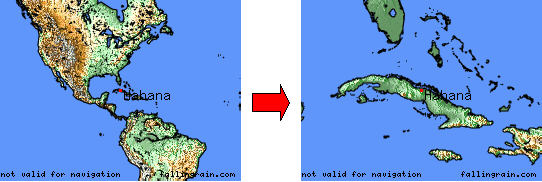
HABITAT:
P.
filifolia is a tropical homophyllous
species, growing in an habitat which is called "sabanas arenosas" (white
sand savannah) in the western part of Cuba. This habitat is caracterized by a
wet soil, while the surface consists of pure white sand, the lower soil layers
are of organic origin.
Introduction
in culture :
Two
clones seems to exist in culture : one with white flower and the other with
violet flower.
CULTURE
AND MULTIPLICATION :
The
following remarks are done according to my own experience and some friends
notes also (mainly from Paul Temple and Laurent Legendre). Pinguicula filifolia is not a
hard plant to grow but a hard plant to keep alive during coldest temperatures.
I had the chance to have access in the past to unlimited quantities of P. filifolia from In-vitro(not now) and tried differents medias and way of
growing.
P.
filifolia can grow on mostly sandy substrate, usual carnivorous peat media,
pure laterite, live sphagnum, calcareous media, vermiculite/perlite mix and my
usual mexican mix. There is not really difference, all work. THe spagnum moss
is the hardest as you have to keep your sphagnum alive. Temperature
is one of the most important parameter as it can kill your plant. I have lost
all my P. filifolia each time during winter despite using heaters or
cable-heater (for snake). I went to the conclusion that a temperature under 20
is dangerous and a minimum temperature of 15°C will kill your plant in few
weeks. receiving P. filifolia in february is far from being a good thing. Humidity
is also an important parameter if you want to have healthy leaves as the
leaves are fragile to dryness 70 or more is perfect.
Watering
the plant is also important. My friend that did in-vitro noted that the roots
of P. filifolia produced poison (toxics ?) that will lead to the poisonning of
the plants. In in-vitro, the first media is a clear colour and then turn in
few weeks yellow, then orange and finally brown and 4 months and the plants
die then. You must change your in-vitro media before brown. It is amazing to
note that the plants are divided faster as the colour is changing to brown. An
survival instinct ?. Is it the same in our growing media ? I don't know but I
overwater the plants each month and the rest of the time by under. Producing
seeds is something I have never succeed yet : We note that the flowers need to
be in a drier area than the leaves to have a live production of pollen and a
production of seeds. This is not easy to do as if you grow your plant in a
aquarium closed for having a good humidity (100%). The flowers will not
produce seeds despite dozen of flowers and tries to pollinate. This
is explain as follow in habitat : the plants are surrounded by grasses so the
leaves are in a good humidity area protected by the sun. THe flowers are up
the grasses and the sun will give a drier area that allow succeeded
pollinisation
I
grow my plant in my green house as soon as the temperature are over 20°C (May
or later for exemple) until september. The rest of the time, it is inside my
house in a aquarium closed. If you want to
have seeds in an aquarium, the method is the following : buy a high aquarium
(40 cm or 50 cm is perfect), the light (light tube type biolux or white) must
be over the aquarium without glass between the tube and the top of the
aquarium. Then the tube must be covered by a cover that cover all the
aquarium. The water level must be 3 cm but the bottom of the pot must not stay
in this level. Use something to elevate a little for having only 1/2 cm
of the bottom of the pot wet. The humidity will be high and the flowers will
be nearly touching the tube where the humidity is less abundant and you
could produce seeds.
PICTURES: (click to enlarge)
|
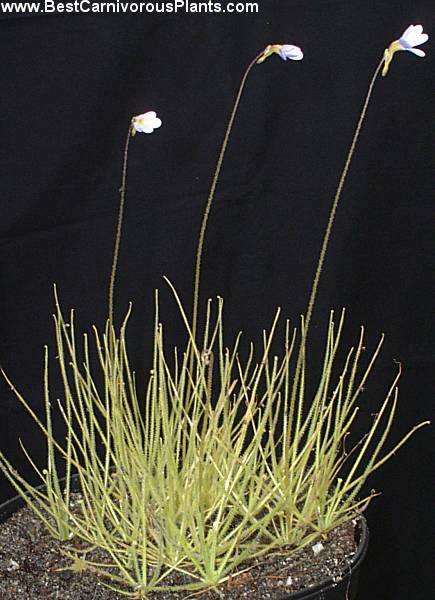
Cluster
of Pinguicula filifolia in culture.
Photo
: Jan Flisek
www.Bestcarnivorousplants.com |
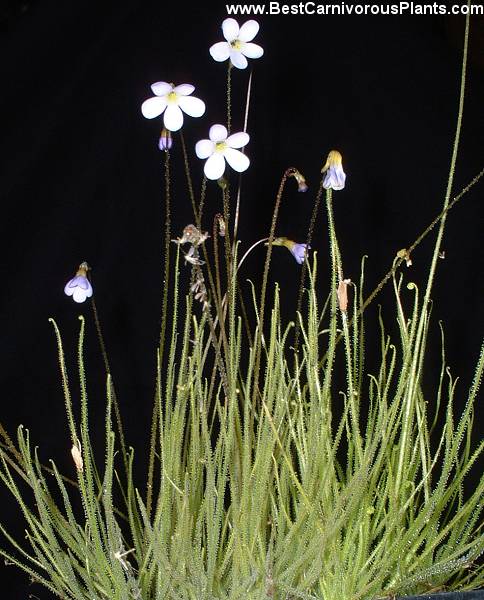
Cluster
of Pinguicula filifolia flowering in culture.
Photo
: Jan Flisek
www.Bestcarnivorousplants.com |
|
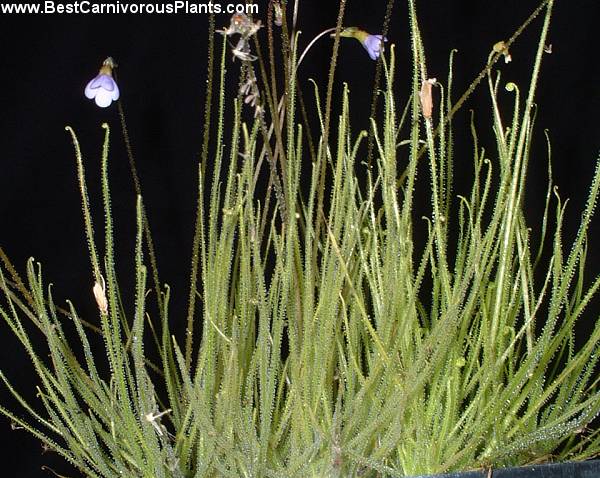
Cluster
of Pinguicula filifolia in culture.
Photo
: Jan Flisek
www.Bestcarnivorousplants.com |
.jpg)
Cluster
of Pinguicula filifolia.
Photo
: Hervé Huet
-
February 2003 -
|
|
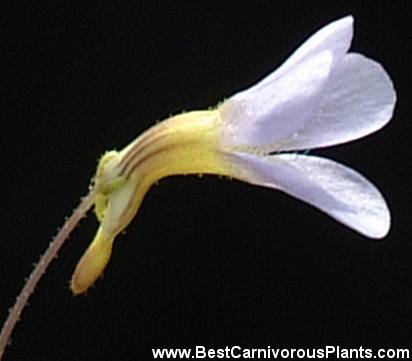
Close-up
of the violet flower of Pinguicula filifolia.
Photo
: Jan Flisek
www.Bestcarnivorousplants.com |
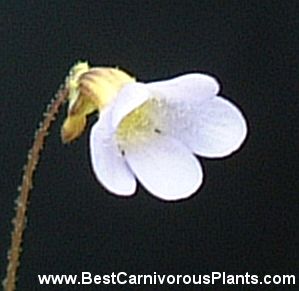
Close-up
of the violet flower of Pinguicula filifolia.
Photo
: Jan Flisek
www.Bestcarnivorousplants.com |
|
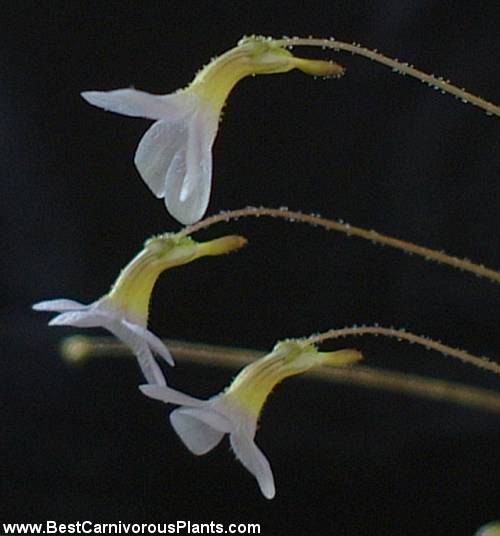
Violet
flowers of Pinguicula filifolia in culture.
Photo
: Jan Flisek
www.Bestcarnivorousplants.com |
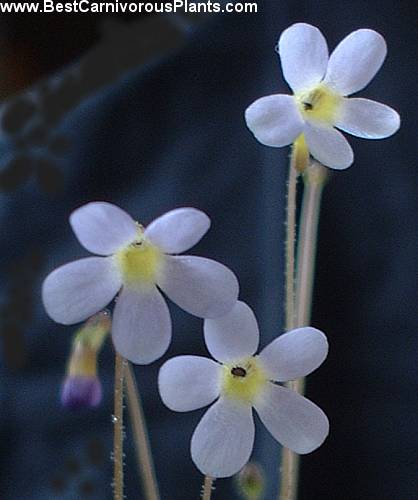
Violet
flowers of Pinguicula filifolia in culture.
Photo
: Jan Flisek
www.Bestcarnivorousplants.com |
|
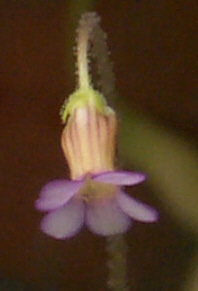
Close-up
of the violet flower of Pinguicula filifolia.
Photo
: Hervé Huet
-
February 2003 -
|

Close-up
of the clone of Pinguicula filifolia with white flower.
Photo
: Jan Flisek
www.Bestcarnivorousplants.com |
| Below :
Pictures of Pinguicula filifolia in habitat in Cuba
from Isla de la Juventud.
All
pictures by Yoannis Dominguez Rodriguez |
|
|
.jpg)
Typical landscape of white sand
savannah.
Photo : Yoannis Dominguez
Rodriguez
|
.jpg)
White
sand savannah, the habitat of Pinguicula filifolia in Isla de la
Juventud.
Photo :
Yoannis Dominguez Rodriguez |
|
.jpg)
White
sand savannah, the habitat of Pinguicula filifolia in Isla de la
Juventud.
Photo :
Yoannis Dominguez Rodriguez
|
.jpg)
White
sand savannah, the habitat of Pinguicula filifolia in Isla de la
Juventud.
Photo :
Yoannis Dominguez Rodriguez
|
|
.jpg)
Yoannis
studying Pinguicula filifolia.
Photo :
Yoannis Dominguez Rodriguez
|
.jpg)
Pinguicula
filifolia in habitat.
Photo :
Yoannis Dominguez Rodriguez |
|
.jpg)
Pinguicula
filifolia in habitat.
Photo :
Yoannis Dominguez Rodriguez |
.jpg)
Pinguicula
filifolia in habitat surrounded by a pest : Cassytha filifolrmis.
Photo :
Yoannis Dominguez Rodriguez
|
| |
.jpg)
Pinguicula
filifolia in sandy soil.
Photo :
Yoannis Dominguez Rodriguez
|
|
.jpg)
Circinate
prefoliation of Pinguicula filifolia.
Photo :
Yoannis Dominguez Rodriguez
|
.jpg)
Pinguicula filifolia
with prey.
Photo :
Yoannis Dominguez Rodriguez
|
|
.jpg)
Pinguicula filifolia in habitat.
Photo :
Yoannis Dominguez Rodriguez
|
.jpg)
Pinguicula
filifolia in habitat.
Photo :
Yoannis Dominguez Rodriguez
|
|
.jpg)
Pinguicula
filifolia in peaty soil.
Photo :
Yoannis Dominguez Rodriguez
|
.jpg)
Pinguicula
filifolia in habitat with plantlets. Note the white sandy soil.
Photo :
Yoannis Dominguez Rodriguez
|
|
.jpg)
Pinguicula
filifolia with prey.
Photo :
Yoannis Dominguez Rodriguez
|
.jpg)
Pinguicula filifolia with prey.
Photo :
Yoannis Dominguez Rodriguez |
|
.JPG)
Pinguicula
filifolia fruit.
Photo :
Yoannis Dominguez Rodriguez
|
.jpg)
Variations
in flowers of Pinguicula filifolia.
Photo :
Yoannis Dominguez Rodriguez
|
.jpg)
Pinguicula filifolia with double spur.
Photo :
Yoannis Dominguez Rodriguez
|
.jpg)
Pinguicula
filifolia with 6 corolla lobes.
Photo :
Yoannis Dominguez Rodriguez
|




.jpg)






.jpg)
.jpg)
.jpg)
.jpg)
.jpg)
.jpg)
.jpg)
.jpg)
.jpg)
.jpg)
.jpg)
.jpg)
.jpg)
.jpg)
.jpg)
.jpg)
.jpg)
.JPG)
.jpg)
.jpg)
.jpg)